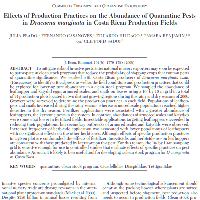Resumen
-
To mitigate risks of invasive pests, international nursery exporters may soon be expected to participate in clean stock programs that reduce the probability of shipping crops that contain pests of quarantine significance. We worked with Costa Rican producers of Dracaena marginata Lam. (Ruscaceae) to identify critical pests, as well as the field conditions and production practices that could be explored for lowering pest abundance in a clean stock program. We sampled the abundance of leafhopper and katydid eggs, armored scales, and snails on leaves using a 10- by 10-m grid in a total of 34 production plots located in two distinct growing regions during the rainy and dry seasons of 2006. Growers were surveyed to determine the production practices in each field. Populations of leafhoppers and snails increased during the rainy season, whereas armored scale populations reached higher densities in the dry season. Fertilizer applications were associated with a greater abundance of leafhoppers, the keystone pests in the system. In contrast, abundances of armored scales and katydids were somewhat lower in fertilized fields. Insecticide applications targeting leafhoppers succeeded in reducing their populations, but secondary outbreaks of armored scales and katydids were observed. Increased frequency of herbicide application was associated with lower populations of leafhoppers with no significant effects on the other herbivores. Although effects of specific production practices in a given plot are confounded, the effects of fertilizer, insecticide, and herbicide use on leafhoppers are consistent with those predicted by literature on this pest. For this reason, the 10- by 10-m sampling grid is sensitive enough for use in controlled studies that evaluate effects of specific practices on pest abundance. As such, it is likely to be a useful tool for developing a clean stock program for D. marginata in Costa Rica.
